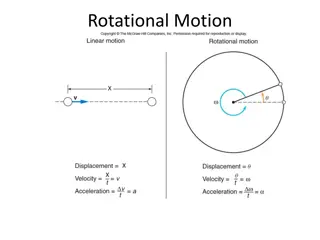Understanding Moment of Inertia and its Importance in Mechanics
Moment of Inertia (MoI) is a crucial concept in mechanics, representing a body's resistance to rotation. It depends on the shape of the object and influences the torque required for rotation. This property plays a significant role in structural mechanics and stress analysis, contributing to understanding stress distribution and deflection in loaded structures. The concept of moments of inertia for area, defined in terms of integral terms, further aids in analyzing stress and deflection patterns in various structures.
Download Presentation

Please find below an Image/Link to download the presentation.
The content on the website is provided AS IS for your information and personal use only. It may not be sold, licensed, or shared on other websites without obtaining consent from the author. Download presentation by click this link. If you encounter any issues during the download, it is possible that the publisher has removed the file from their server.
E N D
Presentation Transcript
Moment of Inertia Moment: it is the torque created by a force, so it is a turning force and it is equal to: Lecture 10 Mo= F x d What is Moment of Inertia ( MoI )? It is the moment required by a solid body to overcome it s resistance to rotation. It is resistance of bending moment of a beam It is the second moment of mass (mr2) or second moment of area (ar2), it s unit is ( m4) or ( kgm2) m1 Moment of inertia : It is the mass property of a rigid body that determines the torque needed for a desired angular acceleration about an axis of rotation. Moment of inertia depends on the shape of the body and may be different around different axes of rotation. A larger moment of inertia around a given axis requires more torque to increase the rotation, or to stop the rotation of a body about that axis. m1 = m2 m2 ( m1) has a larger ( MoI ) than ( m2), so it needs more torque to rotate it. 1
Lecture 10 Moment of Inertia for Area To understand the concept of ( MoI ) for Area, lets Consider a plate submerged in a liquid. Liquid surface The pressure of a liquid at a distance z below the surface is given by: p = . z where: is the specific weight of the liquid. The force on the area ( dA) at that point is: dF = p . dA The moment about the x-axis due to this force is [ z . (dF) ], the total moment is: Az . dF = Az . P . dA = A . z2 . dA = . A( z2. dA) = . I where: the integral term is referred to as the moment of inertial of the area of the plate about an axis. A( z2. dA) = I = the moment of inertia for area or the second moment for area This sort of integral term also appears in solid mechanics ( strength of material ) when determining stresses and deflection. 2
Moment of Inertia for Area Consider three different possible cross sectional shapes and areas for the beam ( RS ). All have the same total area and, assuming they are made of same material, they will have the same mass per unit length. Lecture 10 For the given vertical loading ( F ) on the beam, which shape will develop less internal stress and deflection? Why? The answer depends on the ( MoI ) of the beam about the x-axis. It turns out that Section ( A ) has the highest ( MoI ) because most of the area is farthest from the x axis. Hence, it has the least stress ( T ) and deflection : T = M . y / I as ( I ) increases, ( T ) or stress decreases. 3
Moment of Inertia for Area The Rectangular moments of inertia Ixand Iyof an area are defined as: Lecture 10 For the differential area ( dA), shown in the figure: d Ix = y2. dA d Iy = x2. dA The Polar moments of inertia Ixand Iyof an area are defined as: d JO= d JO= d JO = d Ix+ d Iy where: ( JO) is the polar moment of inertia about the pole ( O ) or ( z axis ). r2. dA = ( x2+ y2) . dA x2. dA + y2. dA The moments of inertia for the entire area are obtained by integration. Ix= Ay2. dA ; JO= Ar2. dA = A( x2 + y2 ) . dA= Ix+ Iy The ( MoI ) is also referred to as the second moment of an area and has units of length to the fourth power (m4or in4). Iy= Ax2. dA 4
Moment of Inertia for Area Radius of Gyration: Lecture 10 To understand the concept of radius of gyration, suppose that a rigid body is made up of large number of identical particles; each of mass ( m ). Let ( r1, r2, r3 .rn) be the perpendicular distances of these particles from the axis of rotation as shown in figure. Then the ( MoI ) of the body about the axis is given by: rn m Multiplying and dividing by ( n ) of the equation, it becomes: m r1 O r3 m r2 m Where: M is the total mass of the body. 5
Moment of Inertia for Area Lecture 10 The radius of gyration of an area ( A ) with respect to the ( x axis ) is defined as the distance ( kx). where: Ix= kx. A With similar definitions for the radii of gyration of ( A ) with respect to the ( y axis ) and with respect to ( O ), we have: Parallel - Axis Theorem for an Area: This theorem relates the moment of inertia (MoI) of an area about an axis passing through the area s centroid to the ( MoI ) of the area about a corresponding parallel axis. This theorem has many especially when working with composite areas. practical applications, Consider an area with centroid ( C ). The ( x' and y' ) axes pass through ( C ). 6
Lecture 10 Parallel - Axis Theorem for an Area: The ( MoI ) about the ( x-axis ), which is parallel to, and with distance ( dy) from the ( x ' axis ), is found by using the parallel-axis theorem. IX = Ay 2dA = A(y' + dy)2dA = Ay' 2dA+ 2 dy Ay' dA+ dy 2 AdA Using the definition of the centroid: y' = ( Ay' dA) / ( AdA) Now, since ( C ) is at the origin of the ( x' y axes ): y = y + dy Ay' dA = 0 y' = 0 , and hence, IX= IX' + A dy IY= IY' + A dX2 2 Thus: Similarly, The polar moment of inertia ( JO) of an area about (O ) and the polar moment of inertia ( JC) of the area about its centroid are related to the distance ( d ) between points (C ) and (O ) by the relationship: JO= JC+ Ad 2 The parallel-axis theorem is used very effectively to compute the moment of inertia of a composite area with respect to a given axis. 7
Lecture 10 Area Moment of Inertia of Common Shapes: The following ( MoI ) is for common & standard shapes that can be used to determine the ( MoI ) for composite area: 8
Lecture 10 MoI for an Area by Integration: For simplicity, the area element used has a differential size in only one direction ( dx or dy ). This results in a single integration and is usually simpler than doing a double integration with two differentials ( dx and dy ). The step-by-step procedure is: 1. Choose the element dA: There are two choices a vertical strip or a horizontal strip. Some considerations about this choice are: a) The element parallel to the axis about which the ( MoI ) is to be determined usually results in an easier solution. For example, it is typically choose a horizontal strip for determining ( Ix) and a vertical strip for determining ( Iy). b) If ( y ) is easily expressed in terms of x (e.g., y = x2+ 1), then choosing a vertical strip with a differential element ( dx ) wide may be advantageous. x Integrate to find the ( MoI ). For example, given the element shown in the figure above: Iy = x2dA = x2y dx Ix = d Ix = (1 / 3) y3dx 2. 9
Examples of ( MoI ) for Area: Lecture 10 Example 1 ( by integration ): Find The ( MoI ) of the area about the x- and y-axes for the shaded area shown in the figure. Solution Ix = y2dA dA = (4 x) dy = (4 y2/4) dy y = 0 y2(4 y2/4) dy Ix 4 = [ (4/3) y3 (1/20) y5] 0 = 34.1 in4 In the above example, it will be difficult to determine ( Iy) using a horizontal strip, thus it is useful to use vertical strip. = x2dA = x2(2 x) dx = 2 0 x 2.5dx = [ (2/3.5) x 3.5] 0 = 73.1 in 4 = x2y.dx Iy x 4 However, Ix in this example can be determined using a vertical strip. So: Ix= (1/3) y3 dx = (1/3) (2 x)3 dx . 10
Lecture 10 Example 2 ( by integration ): polar moment of inertia of a circular area by direct integration. (b) Using the result of part a, determine the moment of inertia of a circular area with respect to a diameter. Solution (a) Determine the centroidal x x 11
Lecture 10 Example 3 ( composite area ): Compute the moment of inertia of the composite area shown in the figure. Solution = 12
Lecture 10 Example 4 ( composite area ): Determine the moments of inertia and the radius of gyration of the shaded area with respect to the x and y axes. Solution 13
Lecture 10 Continue Example 4 ( composite area ): 14























